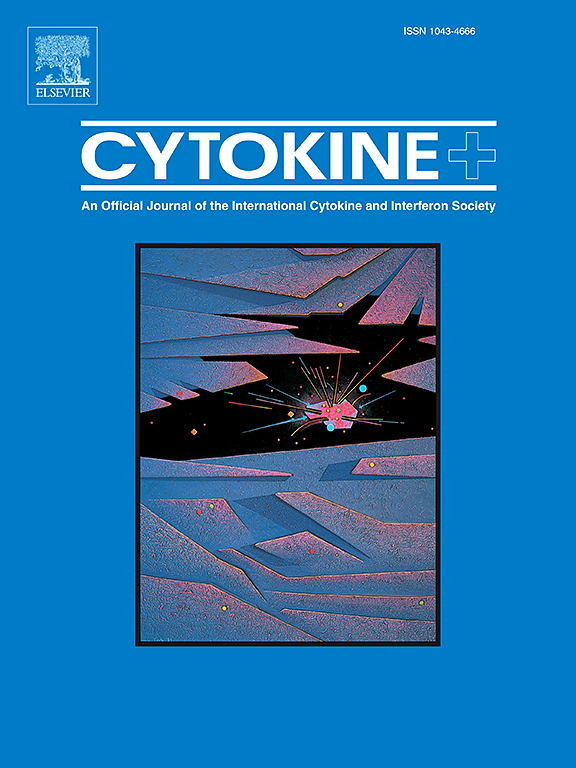Augmented hippocampal up-regulation of immune modulators following a peripheral immune challenge in a hemizygous mouse model of the 15q13.3 microdeletion
IF 3.7
3区 医学
Q2 BIOCHEMISTRY & MOLECULAR BIOLOGY
引用次数: 0
Abstract
The strongest known genetic risk factor for generalized epilepsy is the human hemizygous 15q13.3 microdeletion (MD). This 1.5 Mb MD encompasses six genes, including CHRNA7 encoding the alpha7 subunit that forms the homo-pentameric nicotinic acetylcholine receptor, a known regulator of the immune system. In the CNS, hyper activation of neuroimmune responses contributes to increased seizure susceptibility. In a mouse model with a hemizygous deletion of the orthologous region (Df(h15q13)/+) (Het), we previously demonstrated increased hippocampal expression of inflammatory cytokines compared to wildtype (WT) mice following a mild peripheral immune challenge. To further characterize neuroimmune responses, hippocampal mRNA expression of the chemokines CXCL2 and CXCL10, and the Gap junction protein connexin 43 (GJA1), all of which are implicated in neuronal hyperexcitability, were determined along with additional immune related targets. Three hours after a lipopolysaccharide (LPS, 0.1 mg/kg) or polyinosinic:polycytidylic acid (Poly(I:C), 5 mg/kg) injection (i.p.), hippocampi were collected, mRNA extracted, and cDNA prepared for qPCR. The results demonstrate extensive upregulation of CXCL2 and CXCL10 expression by LPS and Poly(I:C) (up to 200-fold CXCL2, up to 600-fold CXCL10) (p < 0.0001) with genotype x treatment interactions for CXCL2 by LPS (p < 0.007). Responses to treatment were far smaller in magnitude for all other targets. LPS and Poly(I:C) induced statistically similar increases for Toll-like receptor (TLR)2, TLR4, HMGB1, and C3, but Poly(I:C) had stronger effects on GJA1, TLR3, C1qA and MARCO expression. Remarkably, TLR3 was the only target with significant downregulation of expression after Poly(I:C) (p < 0.0001). In addition, genotype x treatment interactions were detected for TLR3, TLR4, HMGB1, and C1qA (p < 0.02). Thus, a peripheral immune challenge caused extensive increases for CXCL2 and CXCL10, and the genotype-treatment interactions that was seen for several targets, underscored the augmented neuroinflammatory response in mice carrying the MD. Of note is the dramatic upregulation of CXCL10 by low dose Poly(I:C). CXCL10 causes hyperexcitability via neuronal CXCR3 activation. Thus, even an asymptomatic viral infection may increase seizure susceptibility. In summary, a peripheral immune challenge causes strong upregulation of hippocampal inflammatory mediators implicated in neuronal excitability which is particularly detrimental for individuals with high seizure susceptibility, such as carriers of the 15q13.3 MD.

在15q13.3微缺失的半合子小鼠模型中,外周免疫攻击后免疫调节剂的海马增强上调
已知最强的广泛性癫痫遗传危险因素是人类半合子15q13.3微缺失(MD)。这个1.5 Mb的MD包含6个基因,包括CHRNA7编码形成同源五聚体尼古丁乙酰胆碱受体的alpha7亚基,这是一种已知的免疫系统调节剂。在中枢神经系统,神经免疫反应的过度激活有助于增加癫痫易感性。在同源区(Df(h15q13)/+) (Het)半合子缺失的小鼠模型中,我们先前证明,与野生型(WT)小鼠相比,在轻度外周免疫攻击后,海马炎性细胞因子的表达增加。为了进一步表征神经免疫反应,海马趋化因子CXCL2和CXCL10以及间隙连接蛋白连接蛋白43 (GJA1)的mRNA表达与其他免疫相关靶点一起被检测,所有这些都与神经元的高兴奋性有关。脂多糖(LPS, 0.1 mg/kg)或多肌苷:多胞酸(Poly(I:C), 5 mg/kg)注射(i.p.) 3小时后,收集海马,提取mRNA,制备cDNA进行qPCR。结果表明,LPS和Poly(I:C)广泛上调CXCL2和CXCL10的表达(高达200倍的CXCL2,高达600倍的CXCL10) (p <;0.0001)与LPS治疗CXCL2的x基因型相互作用(p <;0.007)。对所有其他靶点的治疗反应要小得多。LPS和Poly(I:C)诱导toll样受体(TLR)2、TLR4、HMGB1和C3表达的增加具有统计学意义相似,但Poly(I:C)对GJA1、TLR3、C1qA和MARCO表达的影响更强。值得注意的是,TLR3是Poly(I:C) (p <;0.0001)。此外,检测到基因型x治疗对TLR3、TLR4、HMGB1和C1qA的相互作用(p <;0.02)。因此,外周免疫攻击导致CXCL2和CXCL10的广泛增加,并且在几个靶点上观察到基因型-治疗相互作用,强调了携带MD的小鼠神经炎症反应的增强。值得注意的是,低剂量Poly(I:C)显著上调CXCL10。CXCL10通过神经元CXCR3激活引起高兴奋性。因此,即使无症状的病毒感染也可能增加癫痫发作的易感性。综上所述,外周免疫挑战导致海马炎症介质的强烈上调,这与神经元兴奋性有关,这对具有高癫痫易感性的个体尤其有害,例如15q13.3 MD携带者。
本文章由计算机程序翻译,如有差异,请以英文原文为准。
求助全文
约1分钟内获得全文
求助全文
来源期刊

Cytokine
医学-免疫学
CiteScore
7.60
自引率
2.60%
发文量
262
审稿时长
48 days
期刊介绍:
The journal Cytokine has an open access mirror journal Cytokine: X, sharing the same aims and scope, editorial team, submission system and rigorous peer review.
* Devoted exclusively to the study of the molecular biology, genetics, biochemistry, immunology, genome-wide association studies, pathobiology, diagnostic and clinical applications of all known interleukins, hematopoietic factors, growth factors, cytotoxins, interferons, new cytokines, and chemokines, Cytokine provides comprehensive coverage of cytokines and their mechanisms of actions, 12 times a year by publishing original high quality refereed scientific papers from prominent investigators in both the academic and industrial sectors.
We will publish 3 major types of manuscripts:
1) Original manuscripts describing research results.
2) Basic and clinical reviews describing cytokine actions and regulation.
3) Short commentaries/perspectives on recently published aspects of cytokines, pathogenesis and clinical results.
 求助内容:
求助内容: 应助结果提醒方式:
应助结果提醒方式:


